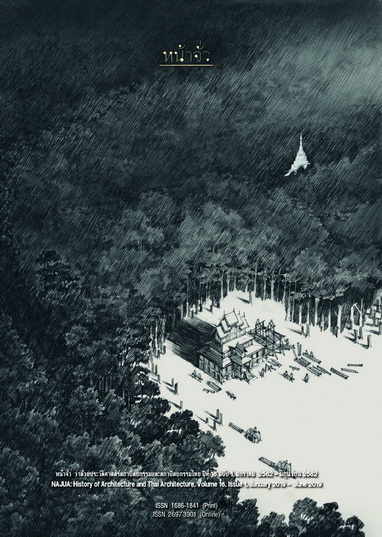Pa-o (Taungthu) Buddhist Monasteries in Thailand and Thaton, Myanmar
Main Article Content
Abstract
The architecture of the Pa-o or Taungthu in Thailand during the 19th to 20th centuries was built by merchants and headmen from Myanmar who were wealthy from teak trade in northern Thailand. Case studies of Pa-o Buddhist monasteries in northern Thailand include Wat Sri Rong Muang and Wat Mon Pu Yak, Lampang; Wat Nong Kham, Chiang Mai; and Wat Nantaram, Phayao. In this study, they were compared with those of the Pa-o in Thaton, Myanmar, where previously was their centre. The study found that Pa-o Buddhist monasteries in northern Thailand and Thaton share similarities; they are a multi-purpose building and the principal architecture of the monastic compound. A monastery includes a Buddha shrine; the main hall for ceremony and dharma preaching; sleeping areas for the abbot, monks, and novice; dining hall; bathrooms; and verandah. However, Pa-o Buddhist monasteries in the two areas differ in directions. Those in northern Thailand face their front to the south, and thus their Buddha shrine is located to the north. Whereas Pa-o Buddhist monasteries in Thaton of Lower Myanmar often place the Buddha shrine to the south and face their front to the north parallel to houses of the Mon who have been the majority in the area. Probably because Lower Myanmar has heavy rainfall and storms coming from the southwest, the Mon thus built their house to the rear of a verandah and staircase situated to the north in order to prevent wind and storms.
Downloads
Article Details
References
Anon Panya Pachato, Phra Samu, “prawat wat nō̜ng kham [History of Nong Kham Temple].” Copy of Documents about Nong Kham Temple’s History.
Boonchuay Sisawat. Khon Thai nai Phamā [Thai Tribe in Myanmar]. Phranakhon: Ramin Press, 1960.
Chotima Chaturawong. “wā thī wat Phamā nai čhangwat Chīang Mai læ lampāng [Monastery of Myanmar in Lampang and Chiang Mai].” Najua: History of Architecture and Thai Architecture, no. 5 (2007): 39-64.
Chotima Chaturawong and Dolina Millar, eds. sathāpattayakam wat Mō̜n nai Phamā tō̜n lāng [The Architecture
of Mon Buddhist Monasteries in Lower Burma]. Bangkok: ET publishing, 2011.
Christensen, Russ and Sann Kyaw. The Pa O: Rebel and Refugees. Bangkok: Silkworm Books, 2006.
Fraser-Lu, Sylvia. Splendour in Wood: The Buddhist Monasteries of Burma. Bangkok: Orchid Press Publishing
Limited, 2006.
Green, Alexandra and T. Richard Blurton. Burma: Art and Archaeology. London: British Museum, 2002.
Hackett, William Dunn. “The Pa-o People of the Shan State, Union of Burma: A Sociological and Ethnographic Study of the Pa-o (Taungthu) People.” Ph.D. dissertation, Cornell University, 1953.
Koizumi, Junko. “Why the Kula Wept: A Report on the Trade Activities of the Kula in Isan at the End of the 19th Century.” Southeast Asian Studies 28, 2 (September 1990): 1-23.
Niti Phawakraphan. chūan thok chāt læ chāttiphan [Discussion to National and Ethnic]. Bangkok: Siam
Publishing, 2014.
Nutthaphol Yurungrengsak. prawattisāt lānnā chabap sangkhēp [History of Lanna]. Nakhonpathom: Slipakorn University Press, 2012.
Prani Wongthet. phēt saphāwa nai suwannaphūm (ʻusākhanē) [Gender in Southeast Asia]. Bangkok: Matichon, 2006.
Sarasswadee Ongsakul, History of Lanna ,11th ed. Bangkok: Amarin Printing and Publishing, 2015.
Somkiat Lophetcharat. phraphuttharūp sinlapa Phamā : prawattisāt chon chāt Phamā kap patimākō̜n rom nai phra phut sātsanā [Burmese Buddha Statues: History of Burmese and Buddhist statues.]. Bangkok: Amarin Printing and Publishing, 2007.
Suchit Wongthes. “nithān chon phao paʻō: sō̜ čhī læ phayānāk [The Story of Pa o: Sochi and Naga].” Salawin Post
(August 16-September 30, 2007: 18.
Surapol Damrikun. [lāikham lānnā [Lacquer Work of Lanna]. Bangkok: Muang boran, 2001.
Sureechai Sukhantharat. “yai khāi sētthakit chāttiphan tō̜ng sū čhāk sāthāranarat hǣng sahaphāp mīa nō̜mā sū thung kulā rō̜nghai rātchaʻānāčhak Thai [Ethnical Economic Webbing of Tongsu Group from Republic of The
Union of Myanmar to Kula Weeping Field in the Kingdom of Thailand].” Ph.D. dissertation, Surindra Rajabhat
University, 2012.
Thippawan Thangmangmee. “kānsưksā phraphuttharūp songkhrư̄ang wat mō̜n pū yak mư̄ang lam pāng [A study Buddha Image Burma Arts at Wat Monpooyak, Lampamg Provice].” Journal of Fine Arts 4, 1 (January-
June 2013): 71-119.
Usanee Thongchai. rāingān kānwičhai sinlapakam læ prawat chumchon rō̜p wat Phamā - thai yai nai nakhō̜n lam pāng [Art and History of Burma-Tai Monastery in Lampang, Thailand, Research report]. Chiang Mai: Archeology Center of the North, Chiangmai University. 2011.
Interview
Chungthun. Director, Pa–O National Development Organization (PNDO). Interview, March 23, 2015.
Ko Chanra knamta. The Pa-O Ethnic. Interview, April 12, 2018.
Pra Rikto Sulata. The Abbot of Huai Makhua Som Temple, The Pa-O Ethnic. Interview, April 12, 2016.


